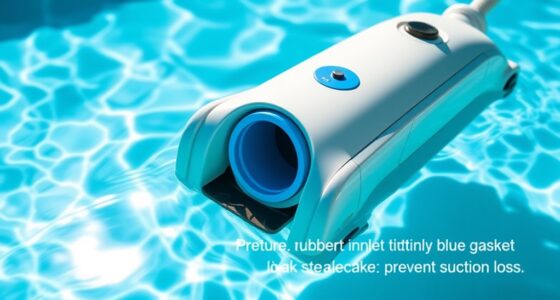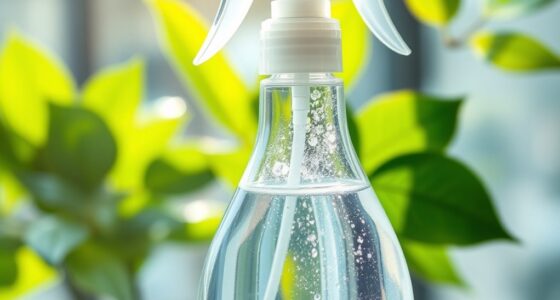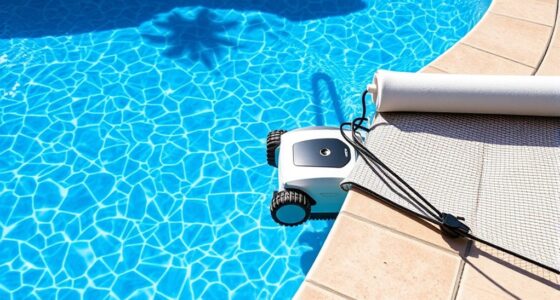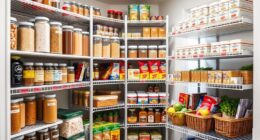Mixing household cleaning products can produce dangerous gases like chlorine, chloramine, or phosgene, which can irritate or severely harm your lungs, eyes, and skin. Common hazards include combining bleach with ammonia, acids, or vinegar; mixing bleach with other disinfectants; or using incompatible drain or oven cleaners. These reactions happen quickly and often without warning, posing serious risks. Stay cautious and discover more about how to keep safe from toxic fumes in this guide.
Key Takeaways
- Mixing bleach with ammonia or acids releases toxic gases like chloramine and chlorine gas, causing respiratory and eye irritation.
- Combining bleach with vinegar, toilet bowl cleaners, or acids can produce dangerous chlorine gas quickly and without warning.
- Using different drain cleaners together, especially acid-based and caustic types, can cause violent reactions and toxic fumes.
- Mixing alcohol-based disinfectants with bleach or other chemicals can generate harmful vapors such as chloroform.
- Combining multiple multi-purpose cleaners containing ammonia or chlorine can produce irritating and hazardous chloramine or chlorinated vapors.
Mixing Bleach and Ammonia
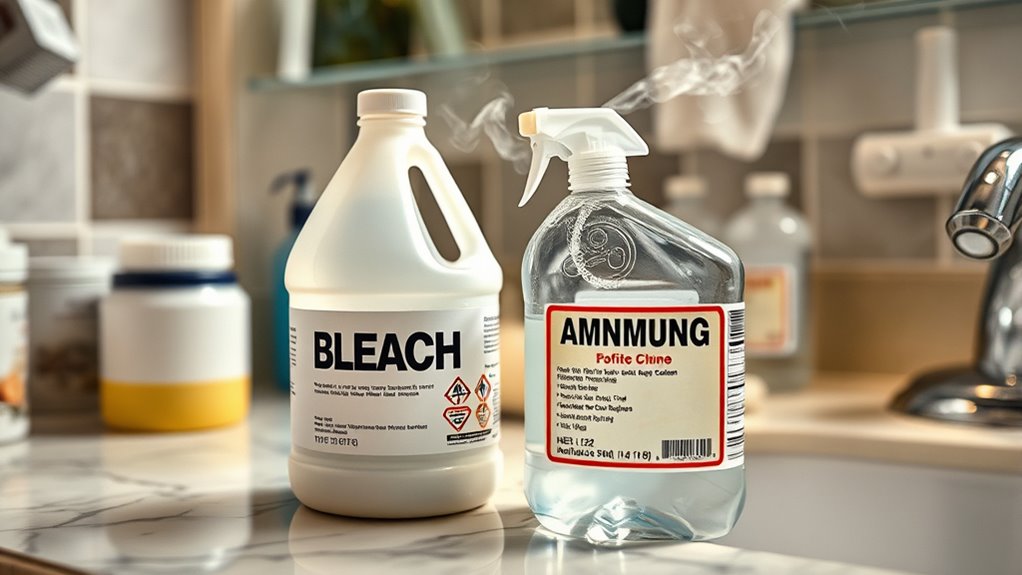
Mixing bleach and ammonia is extremely dangerous because it produces toxic gases that can harm your respiratory system. When combined, these chemicals create chloramine vapors, which are highly irritating and can cause coughing, chest pain, and shortness of breath. In some cases, the reaction produces hydrazine, a highly toxic substance that can lead to lung damage or even more severe health issues. The fumes can quickly fill a room, and inhaling them puts you at risk of serious respiratory problems. Even small amounts of these gases are enough to cause harm, especially in poorly ventilated spaces. Always keep bleach and ammonia separate, and never mix them under any circumstances. Your safety depends on avoiding this dangerous chemical reaction entirely. Essential oils, such as eucalyptus or tea tree oil, should also be kept away from household cleaners to prevent accidental reactions.
Combining Bleach With Vinegar or Acidic Cleaners

When you mix bleach with vinegar or other acidic cleaners, you create toxic chlorine gas that can cause serious health issues. Breathing in this gas can lead to respiratory irritation, coughing, and even more severe problems. It’s essential to avoid combining these products to keep yourself safe. Using proper ventilation when cleaning and avoiding mixing chemicals can help prevent accidental exposure to dangerous gases. Additionally, understanding the chemical reactions involved in common household cleaning can further help you make informed decisions and prevent hazardous situations. Being aware of water safety principles, such as proper storage and handling of cleaning supplies, can also reduce the risk of accidental dangerous gas formation. Recognizing the potential hazards of chemical interactions is crucial for safe cleaning practices.
Toxic Chlorine Gas
Combining bleach with vinegar or other acidic cleaners can produce dangerous fumes, specifically toxic chlorine gas. When these substances mix, they release chlorine gas, which can cause respiratory issues, eye irritation, and even more severe health problems in high concentrations. It’s vital to avoid mixing these products at all costs. To help you recognize risky combinations, here’s a quick guide:
| Safe Cleaning Product | Dangerous Combination |
|---|---|
| Bleach and Water | Bleach and Vinegar or Acidic Cleaners |
| General Cleaning Agents | Mixing Bleach with Acidic Products |
| Disinfectants | Produces Toxic Chlorine Gas |
| Household Cleaners | Can Lead to Harmful Gas Exposure |
Always read labels, and never mix cleaning products to protect your health. Additionally, understanding mammography guidelines can help you stay informed about early detection options for breast health.
Respiratory Irritation Risks
Because mixing bleach with vinegar or acidic cleaners releases toxic chlorine gas, it can quickly irritate your respiratory system. Breathing in these fumes may cause coughing, throat irritation, and shortness of breath. Prolonged exposure can lead to more serious issues like chest tightness or wheezing, especially if you have asthma or respiratory conditions. Even brief inhalation of these gases can cause discomfort and damage your airways. If you notice difficulty breathing or persistent coughing after mixing cleaning products, seek fresh air immediately and consult a healthcare professional. To protect yourself, always use cleaning products in well-ventilated areas and avoid combining substances that can produce harmful fumes. Staying aware of these risks helps prevent respiratory irritation and keeps your airways safe. Additionally, understanding the physiological responses involved can help you better recognize symptoms of gas inhalation and respond appropriately. Regularly checking your ventilation can further reduce the risk of inhaling dangerous fumes during cleaning. Proper chemical handling techniques are essential to prevent exposure and ensure safety while cleaning. Remember, safety precautions are essential when handling chemical cleaners to prevent respiratory harm and ensure your well-being. Incorporating proper protective gear, such as masks and gloves, can further reduce the risk of chemical exposure.
Using Hydrogen Peroxide With Acidic Products

When you mix hydrogen peroxide with acidic products, you risk triggering a dangerous chemical reaction. This combination can produce corrosive gases that may harm your eyes and respiratory system. Always handle these substances carefully and avoid mixing them to stay safe. Additionally, understanding the chemical reactions involved in mixing cleaning agents can help prevent accidental exposure to harmful gases. Being aware of air purifier technology can also aid in maintaining a safe indoor environment by reducing airborne contaminants resulting from such reactions. Proper ventilation and knowledge of glycolic acid benefits can further minimize risks associated with chemical exposure indoors. Recognizing how pH levels influence chemical interactions is crucial for safe cleaning practices, especially since projector technology relies heavily on maintaining optimal conditions for performance and safety.
Chemical Reaction Risks
Using hydrogen peroxide with acidic products can lead to dangerous chemical reactions if you’re not careful. When combined improperly, these substances can produce harmful byproducts that pose health risks. For example, mixing hydrogen peroxide with acids like vinegar or lemon juice can trigger rapid decomposition, releasing oxygen gas. This excessive gas buildup can cause containers to burst or leak. Additionally, you might unknowingly create reactive compounds that irritate your skin, eyes, or respiratory system. Be aware that:
- Releasing oxygen gas unexpectedly
- Increasing pressure in sealed containers
- Producing potentially toxic byproducts
- Causing skin or eye irritation
- Triggering unpredictable chemical reactions
- Understanding chemical interactions helps prevent accidental hazards during cleaning. Proper knowledge of chemical reactions and their potential dangers is essential to avoid harmful outcomes. Recognizing the importance of safe chemical practices can further reduce the risk of accidents. When considering cleaning solutions, it’s important to recognize how home decor materials can influence the safety of chemical use, especially in enclosed spaces.
Additionally, using appropriate protective gear such as gloves and goggles can help prevent injuries during chemical handling. Always read labels and avoid mixing hydrogen peroxide with acidic cleaners unless specified safe. Proper knowledge prevents accidents and keeps your cleaning routine safe.
Corrosive Gas Formation
Mixing hydrogen peroxide with acidic products like vinegar or lemon juice can lead to the formation of corrosive gases that pose serious safety hazards. When combined, these substances react to produce oxygen gas and peracetic acid, which is highly irritating and corrosive. In confined spaces, this reaction can cause pressure buildup or release dangerous fumes, risking respiratory irritation, eye damage, or skin burns. In addition, improper handling of these chemicals can increase the risk of accidents chemical reactions. You might think you’re creating a powerful cleaning solution, but instead, you’re generating harmful gases without realizing it. Always avoid mixing hydrogen peroxide with acids unless specified by a trusted source. Properly ventilate the area if you’re using these products separately, and never combine them directly. Staying informed helps prevent accidents and keeps your cleaning routine safe.
Combining Toilet Bowl Cleaners With Other Chemicals
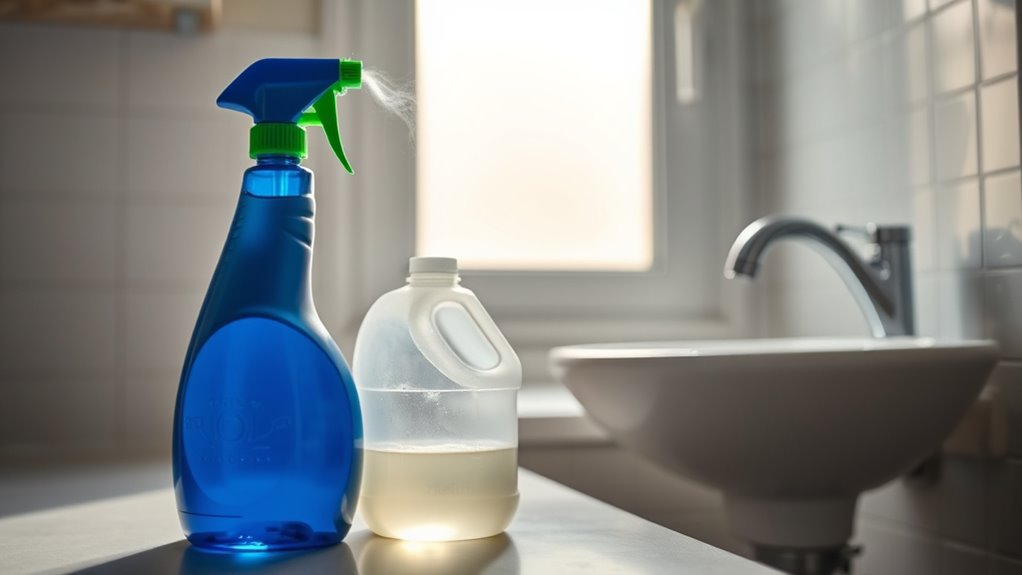
Combining toilet bowl cleaners with other chemicals can be dangerous if you’re not careful. Many people unknowingly mix products, risking harmful reactions. For example, mixing a toilet cleaner containing acids with bleach can release toxic chlorine gas. Here are some common risky combinations:
Mixing toilet bowl cleaners with other chemicals can release toxic gases and cause dangerous reactions.
- Using vinegar-based cleaners with bleach
- Mixing toilet cleaners with ammonia-based products
- Combining acidic cleaners with disinfectants
- Adding bleach to any product containing acids
- Using multiple drain cleaners simultaneously
These combinations can produce hazardous fumes or even cause explosions. Always read labels carefully, avoid mixing different products, and stick to single-use cleaning agents. If you’re unsure about a combination, consult the product instructions or contact professionals. Staying vigilant prevents dangerous chemical reactions and keeps your home safe.
Mixing Rubbing Alcohol With Bleach or Other Disinfectants
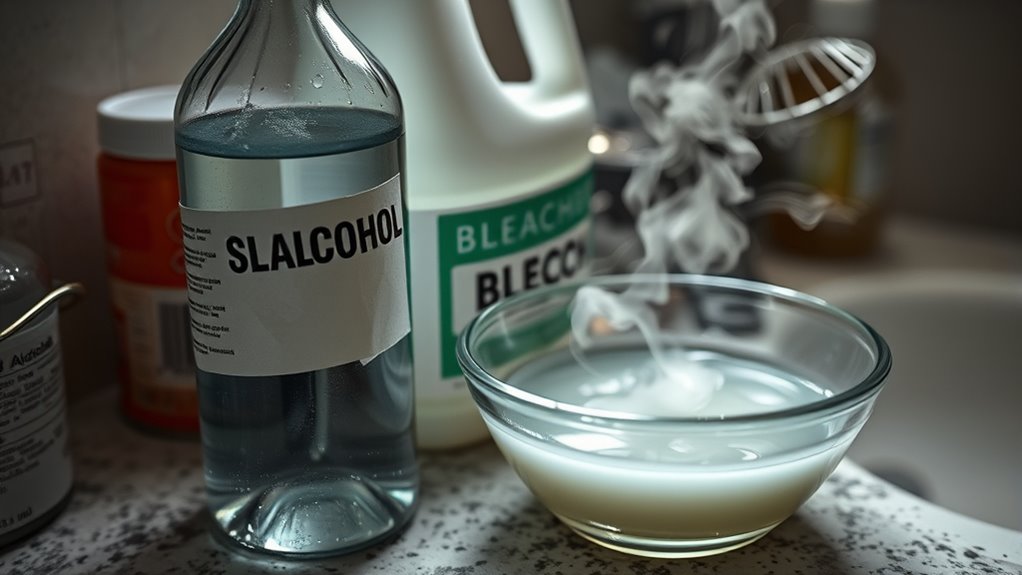
Although rubbing alcohol is a common disinfectant, mixing it with bleach or other disinfectants can be extremely dangerous. When you combine these substances, you risk producing toxic gases like chloroform or chloramine vapors, which can cause respiratory issues, dizziness, or even more severe health problems. Rubbing alcohol contains isopropanol, which reacts with bleach’s sodium hypochlorite, creating harmful compounds. Chemical reactions can occur rapidly and unexpectedly, increasing the risk of exposure to hazardous gases. Kia Tuning techniques often involve chemical modifications, but mixing disinfectants is not one of them and can lead to dangerous chemical reactions—protect yourself by avoiding these combinations entirely. Never mix these chemicals in the same container or use them sequentially without proper ventilation. If you need to switch disinfectants, rinse surfaces thoroughly and wait for fumes to clear. Additionally, understanding cleaning product interactions is crucial for maintaining a safe environment when using multiple cleaning agents. Always read labels and follow manufacturer instructions carefully. Mixing disinfectants intentionally or accidentally can lead to dangerous chemical reactions—protect yourself by avoiding these combinations entirely.
Using Different Types of Drain Cleaners Together
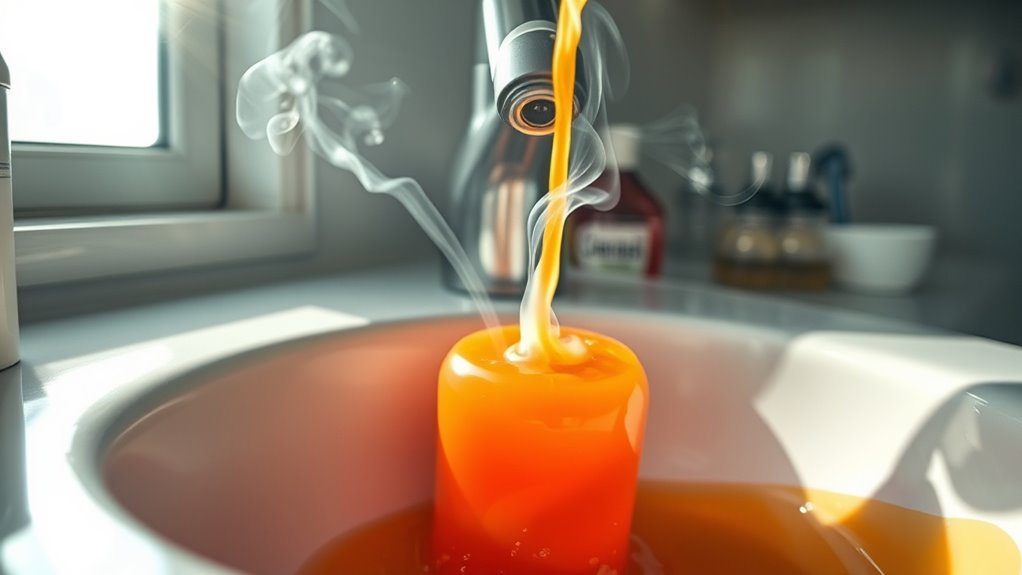
Using different types of drain cleaners together can be very dangerous because their chemical reactions can produce hazardous gases or cause damage to your plumbing. Mixing these products can lead to violent reactions, releasing toxic fumes or damaging pipes. Never combine caustic and acid-based drain cleaners, as they react aggressively. Be cautious about using multiple products in quick succession—what seems safe might not be. Always read labels carefully before applying new cleaners. Here are some key points to remember:
Mixing drain cleaners is dangerous; always read labels and never combine acids with caustics to prevent hazardous reactions.
- Never mix drain cleaners unless specified by the manufacturer
- Avoid combining acid and alkaline solutions
- Use one product at a time, allowing proper flushing
- Wear protective gear to prevent chemical exposure
- Keep a safe distance if you suspect a reaction has occurred
Stay safe by understanding the risks of mixing drain cleaning chemicals.
Combining Multiple Multi-Purpose Cleaners

Mixing multiple multi-purpose cleaners might seem convenient, but it can lead to dangerous chemical reactions or create toxic fumes. Many cleaners contain ingredients like ammonia or chlorine-based compounds, and combining them releases hazardous gases such as chloramine or chlorinated vapors. These fumes can irritate your respiratory system, cause coughing, shortness of breath, or even more severe health issues. Even if a cleaner claims to be versatile, mixing products can unintentionally produce harmful byproducts. Always read labels carefully and stick to one cleaner at a time. If you need to switch products, thoroughly rinse the surface and wait for any residual fumes to dissipate. Remember, using multiple cleaners together isn’t worth risking your health or safety. Better safe than sorry.
Mixing Oven Cleaners With Other Chemical Agents

Mixing oven cleaners with other chemical agents can be extremely dangerous because chemical reactions can produce toxic gases or cause fires. Oven cleaners often contain strong alkalis like sodium hydroxide, which react violently when combined with certain substances. You should never mix oven cleaners with:
- Ammonia-based products
- Bleach or chlorine bleach
- Acids like vinegar or lemon juice
- Other strong cleaning agents
- Commercial drain or toilet cleaners
These combinations can release hazardous gases such as chloramine vapors or chlorine gas, which irritate your eyes, lungs, and skin. In worst cases, they can lead to severe respiratory problems or explosions. Always read labels carefully, use products separately, and never mix cleaning agents to stay safe.
Using Laundry Detergents With Bleach or Stain Removers
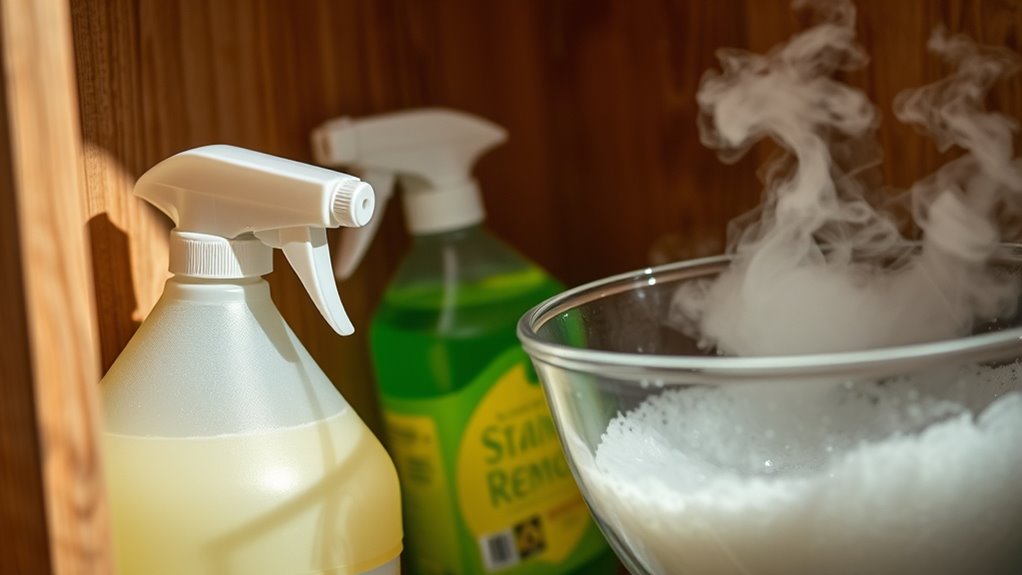
Mixing laundry detergents with bleach or stain removers can cause dangerous chemical reactions. These combinations may produce toxic gases that pose serious health risks. Always follow label instructions to prevent respiratory hazards and chemical accidents.
Toxic Gas Formation
When laundry detergents containing bleach are combined with stain removers or other cleaning products, dangerous chemical reactions can occur, leading to the release of toxic gases. These gases pose serious health risks, including respiratory problems, eye irritation, and even poisoning. To stay safe, be aware of common hazardous combinations. For example, mixing bleach with:
- Ammonia-based cleaners
- Acidic products like vinegar
- Certain toilet bowl cleaners
- Window or glass cleaners
- Some laundry stain removers
can produce chloramine vapors or chlorine gas. These substances are not only harmful to breathe but can cause severe internal injuries. Always read labels carefully, avoid combining products, and use cleaning agents in well-ventilated areas to prevent dangerous gas formation. Safety should always come first when handling household chemicals.
Chemical Reactions Risks
Combining laundry detergents that contain bleach with stain removers or other cleaning products can lead to dangerous chemical reactions. When these substances mix, they often produce hazardous gases like chloramine vapors or chlorine gas, which can cause respiratory irritation, burns, or more severe health issues. For example, mixing bleach with ammonia-based products creates chloramines, which are highly toxic. Similarly, combining bleach with acids found in some stain removers releases chlorine gas, a potent respiratory irritant. These reactions happen quickly and often without warning, especially if you’re not aware of the ingredients involved. It’s essential to never combine bleach with other cleaning agents unless specifically instructed by the product labels. Always read labels carefully and use cleaning products separately to prevent harmful chemical interactions.
Respiratory Hazards
Using laundry detergents with bleach or stain removers can pose serious respiratory hazards if you’re not careful. When these products combine, they release fumes that can irritate your lungs and airways. Breathing in these fumes may cause coughing, wheezing, or shortness of breath, especially if you have asthma or allergies. To stay safe, watch out for these risks:
- Inhalation of chlorine gas from bleach and stain removers
- Respiratory irritation from strong fumes
- Increased asthma flare-ups
- Lung inflammation with prolonged exposure
- Sensitization to cleaning chemicals over time
Always ventilate the area well when using these products, avoid mixing them, and wear a mask if you’re handling large quantities. Protect your lungs and keep your cleaning routine safe.
Combining Disinfectants and Air Fresheners

Although it might seem convenient to spray air fresheners after disinfecting, mixing disinfectants and air fresheners can be risky. Some air fresheners contain chemicals that react with disinfectants, producing toxic gases. These reactions can cause respiratory issues, eye irritation, or even more severe health problems. To stay safe, avoid using air fresheners immediately after disinfectants, especially those containing ammonia or chlorine. Here’s a quick comparison:
| Disinfectant Type | Potential Reaction with Air Fresheners |
|---|---|
| Chlorine-based (Bleach) | Produces chloramine vapors, which are toxic |
| Ammonia-based | Creates harmful chloramine gases when mixed with acids |
| Alcohol-based | Generally safer but can still cause irritation |
| Quaternary Ammonium | Less reactive but can still cause irritation |
Always read labels and ventilate well to prevent dangerous reactions.
Frequently Asked Questions
Can Mixing Cleaning Products Cause Long-Term Health Effects?
Mixing cleaning products can indeed cause long-term health effects. When you combine chemicals like bleach and ammonia, you might produce toxic gases that irritate your respiratory system and damage your lungs over time. Repeated exposure to these fumes can lead to chronic respiratory issues or other health problems. Always read labels carefully, avoid mixing products, and guarantee good ventilation to protect your health from potential dangers.
Are There Any Safe Combinations of Cleaning Agents?
Think of cleaning products as ingredients in a recipe—you need the right mix to avoid a toxic dish. Some combinations are safe, like using soap and water or vinegar and baking soda for simple tasks. Always read labels and follow manufacturer instructions. Never mix bleach with ammonia or other cleaners. Staying cautious guarantees your cleaning effort is a safe and effective dance, not a hazardous misstep.
How Do I Identify Hazardous Chemical Reactions at Home?
To identify hazardous chemical reactions at home, you should watch for warning signs like unusual odors, bubbling, color changes, or smoke. Always read labels carefully and avoid mixing cleaning products, especially ammonia and bleach. If you notice any strange reactions or symptoms like dizziness or breathing trouble, ventilate the area immediately and seek medical help. Keep chemicals stored safely and never mix substances unless you’re sure it’s safe.
What Should I Do if I Accidentally Mix Dangerous Cleaners?
If you accidentally mix dangerous cleaners, act quickly and stay safe. Ventilate the area by opening windows and doors immediately. Don’t try to neutralize the mixture yourself; instead, evacuate the space and call emergency services or your local poison control center. Avoid inhaling fumes, touching the mixture, or trying to clean it up without proper protective gear. Your safety is the top priority in these situations.
Are Store-Bought Cleaning Kits Tested for Safe Chemical Combinations?
Think of store-bought cleaning kits as a well-orchestrated symphony, designed for safety. While brands test their products for safety, they don’t always account for mixing with other cleaners. You should always read labels carefully and follow instructions precisely. If unsure, stick to single products. Remember, even the best orchestra can fall apart with a wrong note—so prioritize safety and avoid mixing chemicals altogether.
Conclusion
Remember, even the most well-meaning cleaning efforts can sometimes stir up a little unintended trouble. By carefully choosing your combinations and avoiding risky pairings, you keep your space safe and fresh without any unexpected surprises. Think of it as a gentle dance—you want to stay in step and avoid stepping on any toes. When in doubt, read labels and give your cleaning routine a thoughtful pause. A little caution keeps your home both sparkling and serene.


